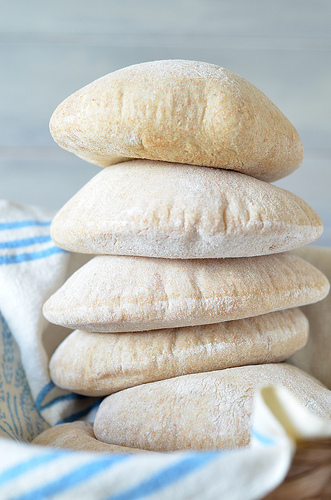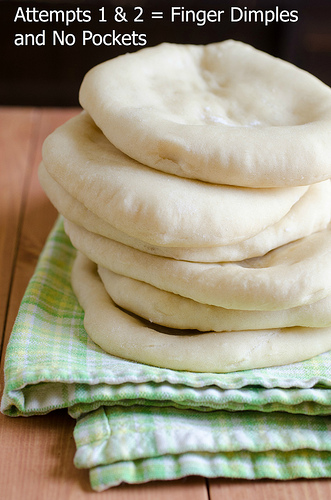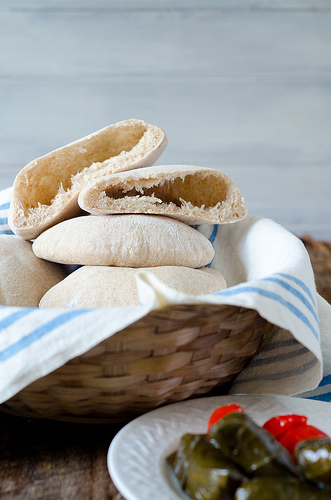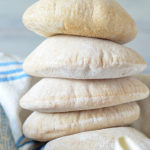
After two attempts, I realized the first glitch in the original recipe. It instructed to roll the discs out using a rolling pin or by hand. I opted for the hand route, then realized that by using my hands/fingers the dough was being pressed too hard in order to delicately puff in the oven. Parts of the pita did rise, but there were dimples all over the surface that screamed "finger prints!" So, attempt number 3 had me shaping the dough with my rolling pin instead.


Other pita recipes I found helpful:
Brown Eyed Baker
The Fresh Loaf
Veg Recipes of India
Recipe Card
Homemade Pita Pockets
Ingredients
- 1 ¼ cup warm water (not hot)
- 1 package instant yeast (about 2 ¼ teaspoons)
- 1 Tablespoon sugar
- 2 Tablespoon olive oil
- 1 ½ cups whole wheat flour
- 1 ½ cups all-purpose flour
- 1 ½ teaspoons salt
Instructions
- Mix water, yeast, sugar and oil in a small bowl; set aside. Whisk together the flours and salt in a large bowl. Pour in the yeast mixture and mix together with wooden spoon until dough forms. If using a stand mixer, use the dough hook attachment to knead at medium speed for 10 minutes. Alternatively you can knead by hand for 10 minutes, until dough is smooth and elastic.
- Transfer the dough to an oiled bowl, turning to cover with oil. Cover bowl tightly with plastic wrap or kitchen towel and let rise in warm place until doubled, about 1 hour.
- Punch down dough and transfer to clean work surface lightly dusted with flour. Form 8 to 9 dough balls, cover with clean damp towel or plastic wrap and let rest for 20 minutes.
- Working with one dough ball at a time on a clean and lightly floured work surface, use rolling pin to shape into about a 6-inch disc (or just smaller). Do not roll too thin. Place on a greased or lined baking sheet, cover with clean kitchen towel and let rest at room temperature for 10 minutes.
- Preheat oven and baking stone to 450 degrees F. Bake 2 to 3 pitas at a time for 5 minutes. They should puff at around 3 minutes. When removing pitas from oven, do not remove the stone so to keep the stone hot. Wait 2 minutes before baking the next batch, to allow the stone to reheat to the correct temperature.
- The pitas are best the same day they are baked. To preserve their freshness for another day, once they are cooled to room temperature, transfer to a freezer bag and store in the freezer for up to 2 months. Defrost in the microwave for about 20-30 seconds.




Fatma says
They are really perfect. I tried them several times. Thank you very much.
April says
I'm going to try this recipe out tonight! I looked over the net and it seems most recipes mirror this one so I'm feeling good about it! I think I will do the dough portion in the bread machine though since I already made 2 things with my mixer yesterday (including loaf bread) and am a bit mixed out! I'll let you know how it turns out!
april says
Oh. Wow. That was amazing!!! Bread machine worked perfectly and the lira's were light and fluffy and so soft. So good!!
Jean says
I was wondering if it is necessary to have a baking stone to bake these or if just a baking sheet would work as well.
Sweetsugarbelle says
These are wow! You're not kidding about things like pitas taking practice...I admire your bravery for even trying. In any case. You're right. Anything dipped in hummus is GOOD!
Nikki says
Thanks, Callye! xoxo!
Gerry @ Foodness Gracious says
Fantastic! I love your determination to get them just right,
Great post..
Casey says
I think it is great that you kept trying until you got something really special.
Christina @ Sweet Pea's Kitchen says
Your pitas look amazing! I love having gyros for dinner but I usually just buy the store bought pitas to save time. These pitas look like they would be worth the effort! 🙂
Candy G. says
I would love this straight off the spoon!!!!!
Tara @ Musical Soup Eaters says
These look wonderful. Your timing is perfect--I have been planning to start making homemade versions of foods I would normally buy. I bet that these taste a lot better than store bought pita bread, especially when they're fresh.
Nikki says
Hi Tara. They definitely taste better than store bought, and yes, especially when fresh. (Which is why if I don't use them right away, then I bag them up and freeze them.) 🙂
dassana says
the pitas are looking like wonderfully fluffed pillows.... thanks for the mention nikki.
Nikki says
No problem, Dassana! Your recipe is the one that really got me in the right direction! 🙂
Kristen says
I loved realizing I can make my own pita bread... so good!! Yours look beautiful!
Nikki says
Thanks, Kristen!
Jessica @ Sunny Side Up says
Are you reading my mind?! I have been thinking of making pitas a lot lately. This recipe and your ideas are just the nudge I need!
Nikki says
Of course, Jess! I'm always reading your mind...duh! 😉
Julie @ Table for Two says
yours turned out so gorgeous!! third time's a charm, eh?
Suzanne Perazzini says
Thank you for doing the testing so we don't have to. I have never tried to make these and since I have an unreliable oven I'm not too sure how they will turn out. But God loves a trier.
[email protected] says
I've had problems with homemade Pita Bread, too. You just have to be really careful. However, I rarely use mine with the pockets opened. I use them for pizza crust; pita chips; open face sandwich; folded like a taco; sometimes split horizontally; and sometimes I put butter, garlic salt and cheese on them, heat them, and cut them in triangles for bread.
I think they're worth making even if you can't open them and use the pockets.
Nikki says
Hi Patty. I agree. This isn't the pita bread recipe that I would use for flat pita bread, which is why I decided to title these Pita Pockets instead of pita bread. 🙂 But, if they fail to give pockets, then definitely use them for the examples you gave (and I also gave some of the same in my post above.) Thanks!
tanya1234 says
have to try thankxxxxx
Katrina @ Warm Vanilla Sugar says
So fun! Great idea!
Erin @ Texanerin Baking says
Good for you for not giving up! I don't like gyros but I do love to eat plain pita. Just give them to me empty and I'll happily munch away until someone stops me. You got some wonderful puffiness with yours! Very pretty. 🙂